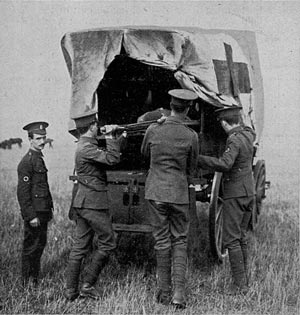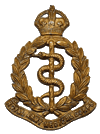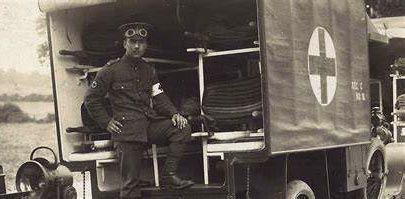Gunner
 |
| Medical Corps WWI |
Charles Robinson
Service Number:
4017
831618
286289
 Regiment & Unit/Battalion
Regiment & Unit/Battalion
Royal Army Medical Corps
2nd South Midland Field Artillary Brigade
3/2nd S M Bde RFA
Date of Death
4th qtr., 1972.
Buried or commemorated at
Broadwas Roll of Honour
Country of Service
United Kingdom
Additional Info
Son of Mr. and Mrs. Henry Robinson
Family history
Henry Robinson married, Alice Key in 4th qtr., 1875 [Worcester District] Their son Charles Robinson was born
27th March 1887, St, Swithun's, Worcester
In the 1901 census Charles was living with his uncle and auntie, Thomas and Laura
Putter, at Court Cottages,
Broadwas and was 14 years old.
Charles Robinson married, Gladys Clarinda Watkins, on the 14th April, 1909, in Broadwas, Worcestershire.
They had a son Gerwyn Watkins Robinson, born 12th February 1910, in Broadwas.
In the 1911 census,
they are all living in Broadwas, and they even have a servant, Gertrude Knight, aged 13, born in
Doddenham.
Charles Robinson, joined 3/2nd S M Bde RFA on the 4th December 1916, his address given was, Ashstead Cottages,
Broadwas, Worcestershire.
His occupation was painter, and his birth date was 27th March 1887, he was 28 years and
9 months old, and his height was 5ft 91/2in. Next of kin was given as, Gladys Clarinda Watkins.
In 1939 Register:
Charles Robinson - b. 27th March 1887 - Occupation, Jobbing Builder & Small Holder.
Gwladys C. Robinson - b. 16th July 1884 - Occupation, Unpaid Domestic Duties.
Elizabeth Watkins- b. 15th November 1854 - Pensioner Retired Widowed. [Gwladys' mother]
Address Flying House, Knightwick, Worcestershire.
HISTORY INFORMATION
Royal Army Medical Corps
Each Mounted Brigade contained three regiments of yeomanry; a battery of the Royal Horse Artillery; a Brigade Transport
& Supply Column of the Army Service Corps; and a Field Ambulance. There were fourteen Mounted Brigades established
as part of the Territorial Force in 1908. No additional brigades were created during the war, although each raised a
second and third line reserve.
On 21 March 1918, the enemy launched what was intended to be a decisive offensive, attacking the British Fifth and
Third Armies on the Somme in overwhelming strength. The 61st (2nd South Midland) Division was holding the forward
zone of defences in the area northwest of Saint Quentin in the area of Ham and lost many men as it fought a chaotic
but ultimately successful withdrawal back over the Somme crossings over the next ten days. In the initial clash,
the South Midland faced three enemy Divisions and only began to retire on the afternoon of 22 March, when ordered
to do so in consequence of the enemy's progress at other parts of the line.

|
|
|
Return
©peh




